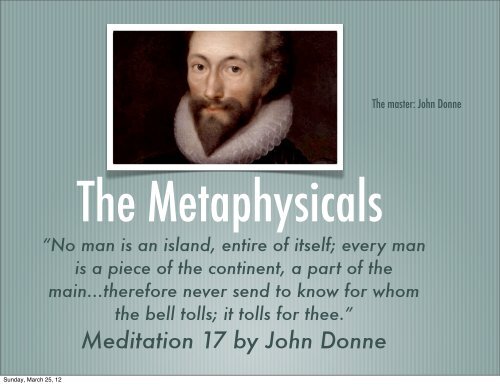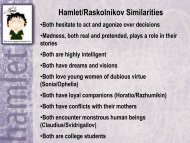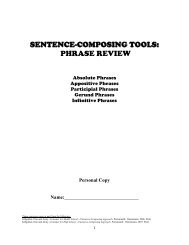Meditation 17 by John Donne - Jenks Public Schools
Meditation 17 by John Donne - Jenks Public Schools
Meditation 17 by John Donne - Jenks Public Schools
You also want an ePaper? Increase the reach of your titles
YUMPU automatically turns print PDFs into web optimized ePapers that Google loves.
Sunday, March 25, 12<br />
The Metaphysicals<br />
“No man is an island, entire of itself; every man<br />
is a piece of the continent, a part of the<br />
main...therefore never send to know for whom<br />
the bell tolls; it tolls for thee.”<br />
<strong>Meditation</strong> <strong>17</strong> <strong>by</strong> <strong>John</strong> <strong>Donne</strong><br />
The master: <strong>John</strong> <strong>Donne</strong>
Use your metaphysical handout for<br />
the following information.<br />
“Metaphysical poetry is concerned with<br />
the whole experience of man, but the<br />
intelligence, learning and seriousness of<br />
the poets means that the poetry is<br />
about the profound areas of<br />
experience especially--about<br />
love, romantic and sensual;<br />
about man’s relationship with<br />
God--the eternal perspective, and, to a<br />
less extent about pleasure, learning and<br />
art.”<br />
Sunday, March 25, 12<br />
<strong>John</strong> <strong>Donne</strong>’s tomb<br />
at St. Patrick’s Cathedral
Some Bullet Points<br />
•Lyric poems<br />
•Brief but intense meditations, characterized <strong>by</strong> striking use of wit, irony<br />
and wordplay.<br />
•Formal structure<br />
•Underlying argument(s)<br />
•love of paradox and reason<br />
•Metaphysical Conceit: A conceit is an elaborately sustained<br />
comparison/metaphor between two dissimilar things. A metaphysical<br />
conceit is characteristic of <strong>17</strong>th c writers influenced <strong>by</strong> <strong>John</strong> <strong>Donne</strong>.<br />
This type of conceit draws upon a wide range of knowledge, from the<br />
commonplace to the esoteric and its comparisons are elaborately<br />
rationalized. Example: In “The Flea” <strong>Donne</strong> compares a flea bite to<br />
the act of love and in “A Valediction: Forbidding Mourning” separated<br />
lovers are likened to the legs of a compass, the leg drawing the circle<br />
eventually returning home to the “fixed foot.”<br />
Sunday, March 25, 12
Imagery<br />
Each poet that we will study concentrates of specific<br />
types of imagery.<br />
•<strong>John</strong> <strong>Donne</strong>: the most eclectic of the three (Marvell, Herbert,<br />
<strong>Donne</strong>), did not write for publication but rather showed his poems<br />
to friends he considered well-read enough to understand his<br />
imagery.<br />
Sunday, March 25, 12<br />
•Alchemy: the mystical beliefs associated with elixir and<br />
quintessence (not so much the gold that we associate with<br />
alchemy)<br />
•Sea-voyages (this was an era of discovery and exploration.<br />
•Mythology<br />
•Religion<br />
•Cosmology (reference to “spheres”)<br />
•Kingship and rule
Imagery continued...<br />
George Herbert: a religious poet.<br />
Anglican priest. Concerned with<br />
man’s whole life in relation to God.<br />
•uses the everyday and the familiar (for his time<br />
period--1600s)<br />
•Paradise: Garden where winter never comes<br />
•Severity: a rod<br />
•Love=God’s bow<br />
•Suffering=a harvest of thorns or bloodletting<br />
•basically, he uses religious imagery and<br />
metaphors<br />
Sunday, March 25, 12
Sunday, March 25, 12<br />
<strong>by</strong> George Herbert<br />
Easter Wings<br />
Lord, who createdst man in wealth and<br />
store,<br />
Though foolishly he lost the same,<br />
Decaying more and more,<br />
Till he became<br />
Most poore:<br />
With thee<br />
Oh let me rise<br />
As larks, harmoniously,<br />
And sing this day thy victories:<br />
Then shall the fall further the flight in me.<br />
My tender age in sorrow did beginne:<br />
And still with sicknesses and shame<br />
Thou didst so punish sinne,<br />
That I became<br />
Most thinne.<br />
With thee<br />
Let me combine<br />
And feel this day thy victorie:<br />
For, if I imp my wing on thine<br />
Affliction shall advance the flight in me.
Sunday, March 25, 12<br />
Henry Vaughan<br />
Welsh physician,<br />
a tad fanatical<br />
Peace<br />
My Soul, there is a country<br />
Afar beyond the stars,<br />
Where stands a winged sentry<br />
All skillful in the wars;<br />
There, above noise and danger<br />
Sweet Peace sits, crown’d with smiles,<br />
And One born in a manger<br />
Commands the beauteous files.<br />
He is thy gracious friend<br />
And (O my Soul awake!)<br />
Did in pure love descend,<br />
To die here for thy sake.<br />
If thou canst get but thither,<br />
There grows the flow’r of peace,<br />
The rose that cannot wither,<br />
Thy fortress, and thy ease.<br />
Leave then thy foolish ranges,<br />
For none can thee secure,<br />
But One, who never changes,<br />
Thy God, thy life, thy cure.
Andrew Marvell: The secular<br />
metaphysical among the bunch.<br />
Imagery:<br />
“Carpe diem” themes<br />
•selective and sparing<br />
•Metaphor of “vegetable love”<br />
•“Green thought in a green shade”<br />
•“Deserts of vast eternity”<br />
• More playful<br />
Sunday, March 25, 12<br />
•image often more memorable and<br />
striking than the idea it expresses.
Understanding the <strong>17</strong>th century mind<br />
The simplified Ptolemaic system,<br />
sometimes called Aristotelian<br />
Everything in the universe was part of one of two distinct worlds: that made up <strong>by</strong><br />
the sublunar and that of the heavenly bodies. The former were made up of earth, fire,<br />
air and water, each of which had its natural motion: earth and water, being heavy,<br />
moved from high to low; while fire and air, being light, moved from low to high. Once<br />
something reached its natural place it no longer moved—much like a pendulum<br />
slowing down until it reaches an equilibrium. This meant that the sublunar world<br />
must consist in a core of earth with the other elements arranged in "shells" around it<br />
—water, air and fire. Since the Earth was mostly earth, it sat at the centre of the<br />
universe and did not move.<br />
Sunday, March 25, 12
Sunday, March 25, 12<br />
According to Pythagorus,<br />
The music of the spheres<br />
involved a very complicated<br />
math theory that expressed<br />
ratios of music numerically<br />
similar to the length and<br />
tightness of strings in<br />
stringed instruments.<br />
Commonly believed (in the<br />
11-<strong>17</strong>th c) that stars were<br />
attached to crystal spheres<br />
revolving around the earth<br />
creating unique harmonious<br />
sounds.
Sunday, March 25, 12
The Quintessence: The 5th Element<br />
Paracelsus noted: "Nothing of true<br />
value is located in the body of a<br />
substance, but in the virtue thereof,<br />
and this is the principle of the<br />
Quintessence, which reduces, say 20<br />
lbs. of a given substance into a single<br />
Ounce, and that ounce far exceeds the<br />
20 lbs. in potency. Hence the less<br />
there is of body, the more in proportion<br />
is the virtue thereof."<br />
The evolutionary perfection includes<br />
within itself the essence of all celestial<br />
and terrestrial creatures." By this<br />
Quintessence or quintum esse,<br />
Paracelsus meant the nucleus of<br />
the essences and properties of all<br />
things in the universal world.<br />
Sunday, March 25, 12
Sunday, March 25, 12<br />
The Elixir of Life.<br />
The transmutation of metals was only<br />
part of the alchemical quest. The other<br />
more elusive goal was the Aqua Vitae,<br />
the so called Elixir of Life.<br />
Throughout history, particularly in the<br />
Middle Ages, there have always existed<br />
those who believe that this Elixir can be<br />
found <strong>by</strong> arcane methods of purifying<br />
substances in conjunction with the<br />
power of the Earth and the planets.<br />
Ancient scroll depicting the<br />
creation of the Philosopher’s<br />
Stone which would allow an<br />
alchemist (experienced and<br />
worth of course) to create<br />
the 5th element and the Elixir<br />
of Life and turn lead to gold.
Sunday, March 25, 12<br />
<strong>17</strong>th century French Globes<br />
Sphere de Copernic Sphere de Ptolemee Globe Terrestre Globe Celeste
Sunday, March 25, 12<br />
<strong>17</strong>th century<br />
compass as per<br />
<strong>John</strong> <strong>Donne</strong>’s<br />
“A Valediction:<br />
Forbidding<br />
Mourning”
For each of the poems<br />
in your packet...<br />
• annotate for rhyme, meter, and poetic devices (sound<br />
and imagery).<br />
• Determine and record the prominent metaphysical<br />
conceit used. Highlight within poem.<br />
• Determine and record “argument presented)<br />
• At the bottom of the poem, write a précis that<br />
introduces the conceit and how it helps illustrate the<br />
Sunday, March 25, 12<br />
theme.






